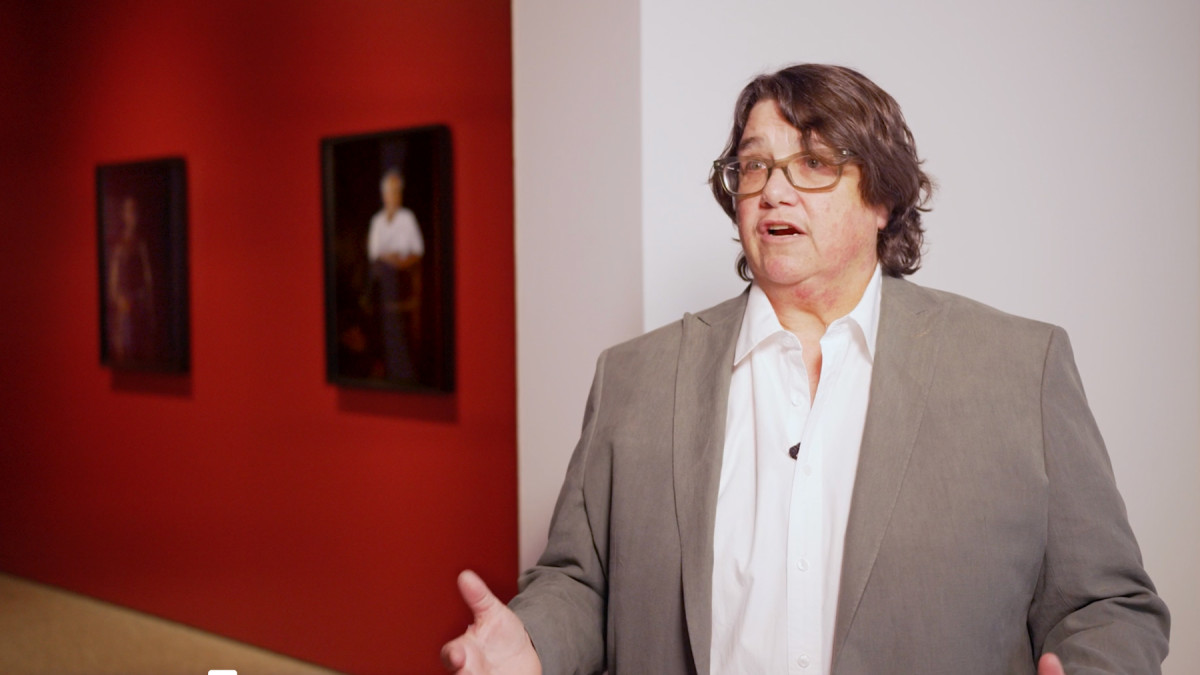Herculine's Profecy
2017 - Sculpture (Sculpture)
243.84 x 121.92 cm
Juliana Huxtable
Herculine’s Prophecy by Juliana Huxtable features a kneeling demon-figure on what appears to be a screen-print, placed on a wooden table, which has then been photographed and digitally altered to appear like a book cover, with a title and subtitle across the top, and a poem written across the bottom. This composition is stuck to a metal plate by a series of button magnets, with interjecting phrases on them. The juxtaposition between the mysogynistic, almost puritan poetry that stripes across the bottom and the powerful crouching pose that the femme demon assumes inverts the hegemonic text , instead creating a space of alterity. The semi-deconstructed book-cover, denotes the seepage of this potential ontological reality (contained within this unwritten book) into the world, allowing Juliana Huxtable’s creation an added layer of possibility.
Writer, artist, performer, and DJ Juliana Huxtable explores intersectional identity through her multidisciplinary practice, which seamlessly blurs the lines that typically separate methods of artistic production. Her work draws from her life experiences, as well as marginalized internet communities, oftentimes featuring hybrid humanoid forms that deeply probe representation of selfhood. In their self-consciously constructed visual ontologies, Huxtable develops a double edged practice that is, on the one hand, a critique of systemic sexist and misogynist power structures, body disassociation and dysmorphia, and on the other, a world-making that frames the radical potential of new technology. Avoiding concrete conclusions, these potentialities become propositions and provocations with which the audience must grapple.
Colors:
Related works featuring themes of: » Bright/Vivid, » Cinematic, » Color Photography, » Feminism, » American

© » KADIST
Catherine Opie
1994Although best known as a provocateur and portraitist, Opie also photographs landscapes, cityscapes, and architecture...

© » KADIST
Catherine Opie
1987In this work, a woman sits on a couch with her shirt pulled up to expose her pierced nipples, which are connected by a chain...

© » KADIST
Nathaniel Dorsky
2010Dorsky’s pieces included in the Kadist Collection are small still photographs from twelve of his most important films...

© » ROYAL ACADEMY
Catherine Opie
Video: Catherine Opie on photographing leading British artists | Blog | Royal Academy of Arts Catherine Opie in the RA Collection Gallery Video: Catherine Opie on photographing leading British artists Read more Become a Friend Video: Catherine Opie on photographing leading British artists Published 8 September 2023 Catherine Opie discusses her portraits of David Hockney, Anish Kapoor, Gillian Wearing, Isaac Julien and Lynette Yiadom-Boakye, featured in our free display in the Collection Gallery...

© » KADIST
Claudia Joskowicz
2015Some Dead Don’t Make a Sound (Hay muertos que no hacen ruido) is a single-channel video by Claudia Joskowicz that features the Mexican legend of the Weeping Woman (La Llorona) as its main protagonist...

© » KADIST
Claudia Joskowicz
2007The primary interest in the trilogy is Joskowicz’s use of cinematic space, with long tracking shots that portray resistance to habitual viewing experiences of film and television...

© » KADIST
Regina José Galindo
2013In 2012, former Guatemalan President José Efran Ros Montt was charged with genocide and crimes against humanity; Regina José Galindo’s video Tierra is a chilling reimagining of the atrocities recounted during his trial...

© » KADIST
Scott Reeder
2013Reeder’s works often start with language—and his Pasta Paintings are no different...

© » KADIST
Lynn Hershman Leeson
2017Using the seminal 1958 film Vertigo as a launchpad, Lynn Hershman Leeson explores the blurred lines between fact and fantasy in VertiGhost , a film commissioned by the Fine Arts Museums in San Francisco...

© » KADIST
Wong Hoy Cheong
2004Re: Looking marks a new phase in Wong’s work which connects his region’s history with other parts of the world...

© » KADIST
Sharon Lockhart
2011Visalia Livestock Market, Visalia, California results from Lockhart’s prolonged investigation of an agricultural center and community...

© » KADIST
Chris Johanson
2000Apartment on Cardboard (2000) is an exterior view of an abstracted apartment building...

© » KADIST
Gregory Crewdson
2005Forest Gathering N.2 is part of the series of photographs Beneath the Roses (2003-2005) where anonymous townscapes, forest clearings and broad, desolate streets are revealed as sites of mystery and wonder; similarly, ostensibly banal interiors become the staging grounds for strange human scenarios...

© » KADIST
Matt Lipps
2011In the series Horizons (2010), Lipps uses appropriation to riff on Modernism’s fascination with abstract form...

© » KADIST
Sharon Lockhart
2008Lockhart’s film Lunch Break investigates the present state of American labor, through a close look at the everyday life of the workers at the Bath Iron Works shipyard—a private sector of the U...

© » KADIST
Chris Johanson
2004Chris Johanson’s paintings, sculptures, and installations break down everyday scenes and commonplace dramas into colorful forms; the darkest sides of humanity are invoked with humor...

© » KADIST
Wong Hoy Cheong
2009Created for the tenth Lyon Bienniale, in Days of Our Lives: Playing for Dying Mother, Wong’s ongoing negotiation of postcolonial globalization takes aim at French society...



